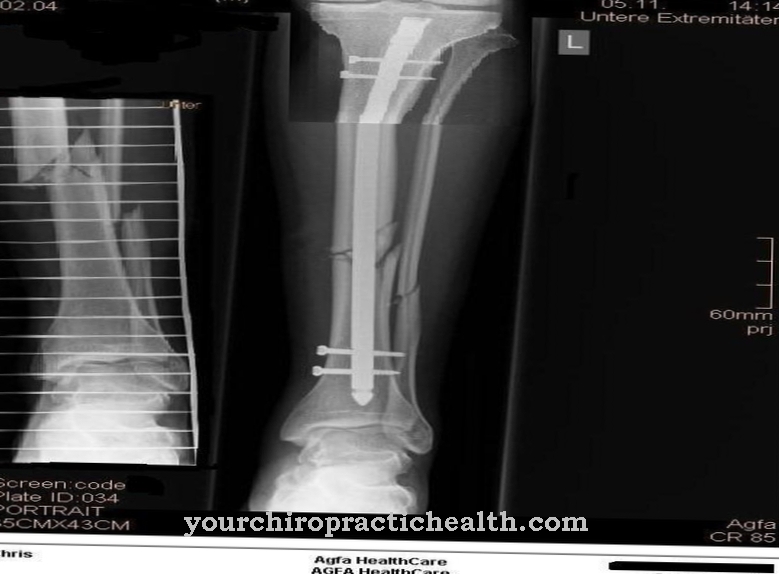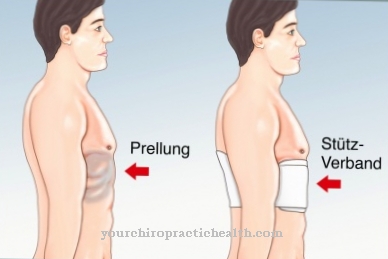Under a Mitral valve prolapse syndrome is understood as a congenital malformation of the heart in the mitral valve apparatus. This leads to a bulging of the mitral valve parts.
What is Mitral Valve Prolapse Syndrome?

© Henrie - stock.adobe.com
At a Mitral valve prolapse syndrome or Mitral valve prolapse the posterior mitral valve leaflet is folded down or expanded into the left atrium of the heart. However, both mitral valves can also be affected. Mitral valve prolapse is one of the most common changes in the heart valves in adults. The incident is more common in women than in men.
The first description of mitral valve prolapse was in 1963 by the heart specialist John B. Barlow from South Africa. Hence the disease also has the names Barlow's disease or Barlow Syndrome. Around five percent of all adults worldwide are affected by mitral valve prolapse. In Germany the rate is between one and two percent. Most cases of prolapse occur between the ages of 20 and 40.
In principle, however, mitral valve prolapse can occur at any age. The mitral valve is located between the left ventricle and the left atrium of the heart. It helps the heart to pump oxygenated blood into the left ventricle via the left atrium. From there it goes on into the organism.
The mitral valve opens when the blood flows in from the left atrium towards the left ventricle. When the chamber is contracted, the heart valve closes. The name mitral valve is due to the similarity of the valve with a miter, a bishop's cap.
causes
Mitral valve prolapse is caused by a disorder of connective tissue. The reasons for this has not yet been clarified. It is believed that genetic influences have an effect. In some people it can occur due to hereditary diseases of the connective tissue, one of which is Marfan's syndrome.
Such diseases result in the mitral valve being stretched, thickened, enlarged or loosened. Sometimes, however, mitral valve prolapse also occurs following a heart attack. It is not uncommon for the papillary muscles to be damaged. This is where the tendon threads of the mitral valve originate.
Symptoms, ailments & signs
Often the symptoms that occur in mitral valve prolapse syndrome are very unspecific. It can be cardiac arrhythmias or symptoms that resemble angina pectoris. Often the patients also experience feelings of shortness of breath, restlessness, fear and fatigue. There is also sharp pain in the chest. Severe symptomatic mitral regurgitation is rare. The same is true of an abrupt loss of consciousness. In many affected people, however, no complaints are noticed at all.
Diagnosis & course of disease
If there are no symptoms, mitral valve prolapse can usually only be discovered by the doctor by chance. To confirm the diagnosis, the heart is monitored (auscultation) and an echocardiography is performed. As part of an auscultation, a systolic click can be heard, which is an expression of the systolic valve leaflet bulging in the direction of the left atrium.
If the patient also suffers from mitral regurgitation, a systolic heart murmur must also be identified. When performing an echocardiography, the thickened valve leaflets are noticeable. The same applies to their systolic protrusion. If mitral regurgitation is suspected, it can be diagnosed with Doppler echocardiography. An EKG examination usually gives normal results.
Sometimes it is also suitable for detecting possible cardiac arrhythmias. A long-term ECG that the patient carries with him for 24 hours is helpful for this purpose. In most cases, the course of mitral valve prolapse syndrome is classified as positive. Serious complications are recorded in only about three percent of all those affected. These include heart failure, arterial thromboembolism and severe cardiac arrhythmias which, in the worst case, can lead to sudden cardiac death.
Complications
The mitral valve prolapse syndrome primarily causes problems in the heart. These complaints can have a very negative effect on the life expectancy of the patient and significantly reduce it. In most cases, there is an inner restlessness and shortness of breath. Furthermore, those affected can also suffer from fear of death and feel very tired.
In most cases it is no longer possible for the patient to drive through strenuous activities or sports due to the mitral valve prolapse syndrome. There is a feeling of exhaustion and the resilience of the person concerned is reduced. The shortness of breath can also lead to a loss of consciousness, which can lead to various complaints or injuries.
In the worst case, the patient dies of sudden cardiac death. If there are acute emergencies, treatment with medication is necessary. There are usually no complications. However, not all complaints can be completely resolved, so that surgical interventions are necessary in some cases.In most cases, mitral valve prolapse syndrome is associated with a reduction in life expectancy.
When should you go to the doctor?
Since the mitral valve prolapse syndrome is a congenital disorder, the first irregularities can appear shortly after birth. An intensive examination is necessary as soon as there are abnormalities in the heart rhythm. If your heartbeat is interrupted, palpitations, or palpitations, you should see a doctor. Normally, newborns are examined in routine examinations immediately after delivery.
If the symptoms of the disease are already pronounced at this stage, they are automatically perceived by the treating pediatricians. Further tests are carried out to enable a diagnosis to be made. Parents should consult a doctor if the initial examinations did not reveal any special features, but the symptoms appear in the first few months or years of life.
If the growing child's resilience is reduced in direct comparison with their peers, the observations should be discussed with a doctor. A doctor is required if breathing disorders, restlessness or increased tiredness occur. In the event of acute respiratory distress, an ambulance must be alerted.
At the same time, first aid measures must be carried out by those present so that adequate medical care is guaranteed until the emergency doctor arrives. Reduced performance, a lack of motivation, exhaustion and sluggishness are indications of a health impairment. A doctor's visit is necessary as soon as the symptoms persist or increase.
Therapy & Treatment
If mitral valve prolapse does not cause any symptoms, medical treatment can be dispensed with. If there is a mitral valve prolapse syndrome that causes symptoms, drug therapy for cardiac arrhythmias or angina pectoris complaints is possible. The patient receives either antiarrhythmic drugs or beta-blockers. If the mitral valve prolapse leads to valve insufficiency, extensive medical therapy is required. Close medical control must take place.
A malfunction of the mitral valve can be compensated by the heart for a certain period of time, as it has an intensifying effect on its performance. By tearing an overexerted tendon nerve, however, there is a risk that the condition of the valve function will abruptly deteriorate further, which is noticeable in acute shortness of breath. Emergency medical treatment is required in such cases. Furthermore, there is a change in the affected ventricle, which is due to increased stress.
As the volume of the heart chamber expands, its muscles thicken at the same time. This threatens a heart failure that can no longer be remedied. Usually an operation of the mitral valve is then necessary. This usually takes place in a minimally invasive manner. Sometimes the mital valve is completely replaced.
If there is a pronounced mitral valve prolapse syndrome, antibiotics should always be given preventively before minor surgery or dental treatment. Even if there are no symptoms of mitral valve prolapse, doctors recommend check-ups every three to five years. In the context of mital valve regurgitation, check-ups must be carried out every six to twelve months.
Outlook & forecast
The prognosis for mitral valve prolapse syndrome is generally very good. In most cases there are no symptoms at all, which is why patients can do without therapy. Only individual check-ups are due. One performance every few years is enough. The quality of life is not affected. Life expectancy remains at the previous level.
Statistically, three percent of all patients experience complications. These are not infrequently serious. One reason for the life-threatening situations is that an adverse change was recognized too late. A diagnosis in the late stage worsens the prospects significantly. The specific risks include endocarditis, cardiac arrhythmias and mitral valve insufficiency. As can be seen, deteriorations in health extend to the heart, which explains the existential dimension of mitral valve prolapse syndrome.
If a patient survives a complication, long-term restrictions cannot be ruled out. Long-term treatment may be indicated. Changes must be accepted in everyday life. Contrary to what is sometimes assumed, the mitral valve prolapse syndrome is not an age phenomenon. Most patients are between the ages of 20 and 40. Women are considered to be a little more vulnerable compared to men.
prevention
There is no special prevention against mitral valve prolapse. The triggering causes are still not known.
Aftercare
Since the mitral valve prolapse syndrome is a congenital disease, there are usually no special follow-up measures available to those affected. Therefore, the patient should ideally consult a doctor early on in this disease so that there are no complications or other complaints in the further course. If the patient or the parents want to have children, genetic testing and counseling should be carried out so that the syndrome can be prevented from recurring.
Most people affected by this disease are dependent on the intake of various medications that can alleviate and limit the symptoms. The person affected should ensure that they are taken regularly and that the medication is correctly dosed in order to alleviate and limit the symptoms.
Regular checks of the internal organs are also very important, with the heart in particular being checked. In general, a healthy lifestyle can also have a positive effect on the progression of mitral valve prolapse, whereby a balanced diet must also be observed. Further follow-up measures are usually not available to those affected with this disease. Life expectancy may be reduced as a result of this disease.
You can do that yourself
The mitral valve prolapse syndrome has very different risks depending on the manifestations. A weak mitral valve prolapse is often not discovered and causes no or only slight discomfort, so that there is no adjustment in everyday life. In cases in which the functional abnormality of the mitral valve is detected, but minimally invasive or surgical intervention is not (yet) recommended, adapting everyday behavior and taking self-help measures can both subjectively and objectively improve general well-being.
In principle, physical and mental stress peaks should be avoided because a sudden flooding of the body with stress hormones leads to an abrupt rise in blood pressure during the beating phase (systole) of the ventricles. This can increase the bulging of one or both leaflets of the valve into the left atrium. On the other hand, it is definitely helpful to encourage the heart to strengthen through light to moderate endurance sports.
Relaxation exercises such as autogenic training, breathing exercises, yoga and other techniques are well suited to deal with acute stressful situations in a way that is gentle on the heart. When it comes to sporting activities, endurance sports such as Nordic walking, swimming, cross-country skiing and playing golf are helpful in strengthening the heart without causing irreversible thickening of the heart walls. It is also important to pay a certain attention to one's subjective well-being when practicing sport, without being fixated and concentrated on it.



























